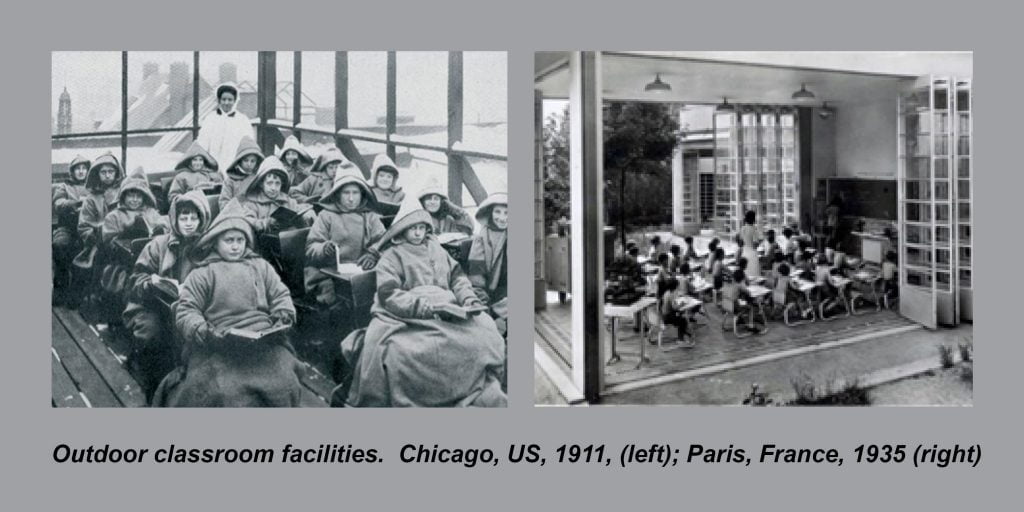Healthy Schools, Healthy Minds
As parents, we often focus on a school’s academic performance, inquire about the curriculum, and get to know the educators who teach our children–but, do we focus enough on the condition of the facilities? The stakes are high. Each day, over 55 million students attend our public and independent schools1. Outside of our homes, the school environment is the place where our children spend most of their time.
The connections between student health, student cognition, and student performance are the focus of a discussion championed by groups and organizations like the Healthy Buildings program at the Harvard School of Public Health. Their publication Schools for Health: Foundations for Student Success, serves as an evidenced-based tool for decision-making by key stakeholders. Similarly, halfway around the world, the Victoria (AU) Department of Education, produced the 2011 literature review, Research into the Connection Between Built Learning Spaces and Student Outcomes. This compendium explores, among many variables, issues including the effects of environmental impacts on student learning. This literature review cites studies for factors such as noise, temperature, air quality, ventilation, and lighting, and their connection to student performance.
Why care? Our nation’s 120,000 school buildings are not receiving the attention they deserve. The American Society of Civil Engineers (ASCE) in its 2017 Infrastructure Report Card identifies an estimated $38 billion-dollar annual gap in funding needed to renew these facilities so they can provide healthy, safe, and modern learning environments. This assessment of condition yielded a D+ grade from the ASCE for calendar-year 2017. Part of the storyline is that of these educational facilities, nearly 75% were built before 1970. This aging infrastructure often poses physical, operational, and educational challenges to our nation’s students, teachers, and administrators. But, relevant research continues to mount and point to the fact that these substandard environments have an impact on our nation’s student performance and achievement.
 Consideration of the physical educational environment and student performance is not a new phenomenon. Early concerns regarding classroom acoustics yielded heavy hung tapestries in early-to-mid nineteenth century classrooms. Similarly, early-to-mid twentieth century concerns regarding student health, the rise of tuberculosis, classroom air quality, and its effect on student performance lead to a movement of open-air schools. These schools, were operated both here in the US, and in Europe from approximately 1910 – 1950. Outcomes and reviews of the success of these facilities was mixed, and their use diminished significantly after mid-century.
Consideration of the physical educational environment and student performance is not a new phenomenon. Early concerns regarding classroom acoustics yielded heavy hung tapestries in early-to-mid nineteenth century classrooms. Similarly, early-to-mid twentieth century concerns regarding student health, the rise of tuberculosis, classroom air quality, and its effect on student performance lead to a movement of open-air schools. These schools, were operated both here in the US, and in Europe from approximately 1910 – 1950. Outcomes and reviews of the success of these facilities was mixed, and their use diminished significantly after mid-century.
Today’s research helps inform us as we consider the planning, design, and use of educational space. Current research identifies connections between the physical learning environment and the student’s ability to learn. Here are a few examples of this research:
- Classroom Acoustics
Children are more sensitive to difficult listening conditions because they are still developing mature language skills. Noise interference in the classroom environment can impair children’s reading, comprehension, and memory. (Stansfeld & Clark, 2015)2 - Classroom Light
Low classroom light levels, and reduced time spent outdoors have been associated with an increased risk for nearsightedness. (Kocak & Sherwin, 2015). - Classroom Attitude
A positive relationship was found between new and or renovated buildings and student achievement based on state academic testing in Virginia (Bullock, 2007). Similarly, a review of the Building Schools for the Future program in England, found that students in new or renovated facilities reported a more positive attitude about school than did students surveyed in facilities where renovations / new construction were currently being built. (PricewaterhouseCoopers, 2010). - Classroom Views
Students in classrooms with green views through their windows have been observed to experience significantly faster recovery from stress and mental fatigue and performed significantly higher on tests of attentional functioning, compared to students in classrooms with no windows or windows looking out on building facades. (Li & Sullivan, 2016)2
The examples shared below are evidence of how this current research is applied in today’s educational planning:
- Recognizing that classroom acoustics play an important role in student learning, acousticians are regularly included as part of the consultant team serving our educational projects. Background noise mitigation, classroom absorption and reverberation, Sound Transmission Coefficient (STC) requirements are areas of focus for this consulting engineer. Often state grant-funding entities, recognizing the importance of acoustical control within the learning environment, will set room guidelines that must be confirmed as met by an acoustical engineer.
- Light levels in classroom spaces are carefully considered. One interesting advance has been the introduction of light shelves to reflect and bounce natural light from the room window area across the ceiling and deeper into the classroom. Coupled with this system are photovoltaic sensors that will automatically dim the artificial lighting of the space as the natural light is able to achieve the required foot-candle levels at the table surface of the room.
- Community interest in US Green Building Council’s, “Leadership in Energy and Environmental Design” or “LEED” certification is often a driver for the incorporation of many of the study topic areas in the planning and construction process. For example, “connection to daylight and views to the outdoors” is one of the design strategies that is incorporated in the USCGB Checklist defining available credits.
- Indoor air quality (IAQ) is a key consideration in the classroom and assembly spaces. The goal of increasing energy efficiency by creating tighter buildings and reducing ventilation rates has historically driven educational environments to conditions that are often sub-optimal for extended periods of concentration and learning. Today’s codes reflect the understanding that fresh air intake is needed to improve these conditions. CO2 sensors in return air ductwork allow mechanical systems to be responsive to the actual number of occupants that may be present in a space. This allows the mechanical systems to ramp up and down in response to the need presented – saving money while meeting the fresh-air intake needs of the occupants.
The above listing of studies, and example applications serves as a sampling of the current work that is going on in support of better understanding the effects of the classroom environment on the learner. As planners, programmers, designers, educators, and parents, we all must continue to search out information in support of evidence-based design, and ultimately create learning spaces that strive to improve the educational environment, and remove encumbrances on the learning process.
__________________________
References:
1 National Center for Educational Statistics – U.S. Department of Education. Fall 2017
2 “Schools for Health: Foundations for Student Success”, Harvard School of Public Health, Center for Health and Global Environment.
3 “Research into the Connection Between Built Learning Spaces and Student Outcomes”, State Government Victoria, AU. Department of Education and Early Childhood Development. Literature Review, Paper No. 22. 2011

